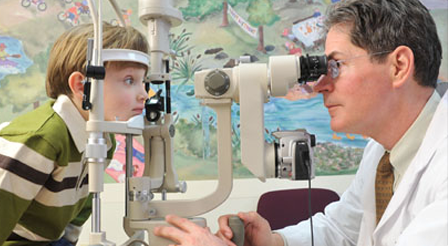Tychsen Lab
Lawrence Tychsen, MD, John F. Hardesty, MD, Distinguished Professor of Ophthalmology and Visual Sciences; Professor, Neurobiology; Professor, Ophthalmology in Pediatrics, Dept of Pediatrics

Research
Dr. Tychsen’s laboratory work is focused broadly on development of binocular vision in infant humans and monkeys, and specifically on neural mechanisms in strabismus (the clinical disorder of crossed-eyes). Studies have shown that infantile strabismus is not due primarily to an eye muscle problem, but rather to malformation of circuits in the CNS. The malformations are manifest as a constellation of visual and motor deficits, which include loss of depth perception, abnormal motion vision and inaccurate eye tracking. These deficits in humans and strabismic monkeys are quantified using measures of perception, visually-evoked cortical potentials and eye movement recordings. In the animal model, injection of neuronal tracers is used to examine CNS circuits that are known to mediate the relevant behaviors. The behavioral-neuroanatomic experiments are carried out in collaboration with Dr. Andreas Burkhalter and are designed to answer three major questions:
- How do the visual and motor circuits in crossed-eyed infants differ from those in normal infants?
- Which miswired circuit caused the eyes to cross in the first place?
- How can we alter the development of these circuits to prevent or cure the disorder?
Publications
View all Lawrence Tychsen’s NCBI publications on PubMed»
Selected or Recent Journal Articles
- Tychsen L, Hoekel J, Ghasia F, Yoon-Huang G. “Phakic intraocular lens correction of high ametropia in children with neurobehavioral disorders.” J AAPOS. 2008 Jun;12(3):282-9
- Tychsen L. “Refractive surgery for children: excimer laser, phakic intraocular lens, and clear lens extraction.” Curr Opin Ophthalmol. 2008 Jul;19(4):342-8.
- Tychsen L. “Causing and curing infantile esotropia in primates: the role of decorrelated binocular input (an American Ophthalmological Society thesis).” Trans Am Ophthalmol Soc. 2007;105:564-93.
- Tychsen L, Richards M, Wong A, Foeller P, Burhkalter A, Narasimhan A, Demer J. “Spectrum of infantile esotropia in primates: Behavior, brains, and orbits.” J AAPOS. 2008 Aug;12(4):375-80.
- Ghasia F, Brunstrom J, Gordon M, Tychsen L. “Frequency and severity of visual sensory and motor deficits in children with cerebral palsy: gross motor function classification scale.” Invest Ophthalmol Vis Sci. 2008 Feb;49(2):572-80.
- Shiels A, Bennett TM, Prince JB, Tychsen L. “X-linked idiopathic infantile nystagmus associated with a missense mutation in FRMD7.” Mol Vis. 2007 Nov 29;13:2233-41.
- Ali A, Packwood E, Lueder G, Tychsen L. “Unilateral lens extraction for high anisometropic myopia in children and adolescents.” J AAPOS. 2007 Apr;11(2):153-8.
- Tychsen L, Hoekel J. “Refractive surgery for high bilateral myopia in children with neurobehavioral disorders: 2. Laser-assisted subepithelial keratectomy (LASEK).” J AAPOS. 2006 Aug;10(4):364-70.
- Tychsen L, Packwood E, Hoekel J, Lueder G. “Refractive surgery for high bilateral myopia in children with neurobehavioral disorders: 1. Clear lens extraction and refractive lens exchange.” J AAPOS. 2006 Aug;10(4):357-63. Erratum in: J AAPOS. 2007 Aug;11(4):417-9.
- Yu JT, Culican SM, Tychsen L. “Aicardi-like chorioretinitis and maldevelopment of the corpus callosum in congenital lymphocytic choriomeningitis virus.” J AAPOS. 2006 Feb;10(1):58-60.